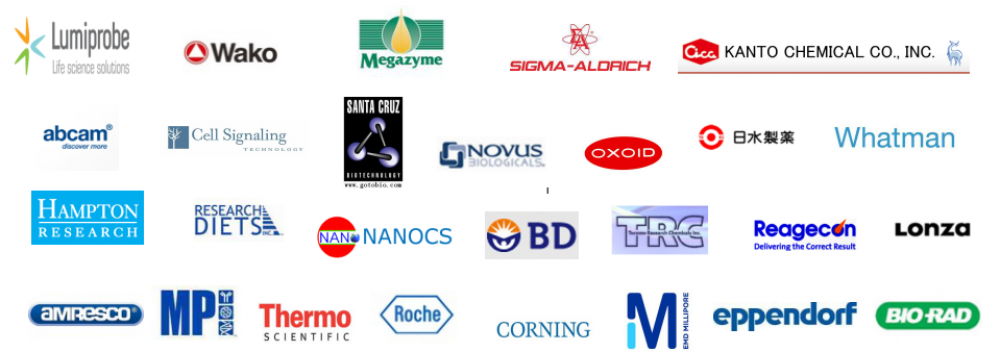Cy5.5 NHS ester 氨基反应性荧光染料,不溶于水
Cy5.5 NHS是近红外胺类活性染料。CY5.5 NHS ester是用于标记多肽、蛋白和寡核苷酸的氨基基团的活性染料。CY5.5属于是近红外荧光染料,当背景荧光有干扰时适宜用它来做标记以进行荧光分析。它也可以用于活体成像实验。该染料可以替代Alexa Fluor 680和DyLight 680。
Cyanine5.5 NHS ester是用于标记含有伯胺的多肽,蛋白和寡核苷酸的反应性染料。 Cy5.5-NHS ester是一种近红外荧光染料,能够溶解在DMF和DMSO中,最大激发光和最大发射光分别在675 nm和693 nm左右[1]。该试剂不仅用于标记含有伯基的分子,而且还用于标记质粒DNA [2]。在生物分子标记中,该标记试剂的水溶性较低,先使用有机溶剂溶解该分子对于高效标记是必需的。首先,Cyanine染料应该溶解在有机溶剂中,然后加入包含生物分子的合适缓冲水溶液中。
通过皮下移植肿瘤小鼠的光学成像,在0.5nmol Cy5.5-NHS注射后30min至24h,皮下U87MG肿瘤可与周围背景组织明显区分开来。 Cy5.5-NHS的肿瘤吸收在注射后30分钟达到最大值,随着时间的推移缓慢洗出[3]。
Cyanine5.5 NHS ester is a reactive dye for the labeling of amino-groups in peptides, proteins, and oligonucleotides, an analog of Cy5.5® NHS ester.
Cy5.5 is a far-red (and near-infrared) emitting dye which is ideal for fluorescence measurements where background fluorescence is a concern. It is also suitable for in vivo NIR imaging experiments.
This reagent can replace NHS esters of Cy5.5®, Alexa Fluor 680, and DyLight 680.
General properties
| Appearance: | dark blue powder |
| Molecular weight: | 716.31 |
| Molecular formula: | C44H46ClN3O4 |
| Solubility: | soluble in organic solvents (DMSO, DMF, dichloromethane), low solubility in water |
| Quality control: | NMR 1H (95%) and 13C, TLC, functional testing |
| Storage conditions: | Storage: 24 months after receival at -20°C in the dark. Transportation: at room temperature for up to 3 weeks. Avoid prolonged exposure to light. Desiccate. |
| MSDS: | Download |
Spectral properties
| Excitation maximum, nm: | 673 |
| Extinction coefficient at excitation maximum, Lmol-1cm-1: | 209000 |
| Emission maximum, nm: | 707 |
| Fluorescence quantum yield: | 0.2 |
氨基分子的NHS酯标记
NHS (N-HydroxySuccinimide) esters and other activated esters (sulfo-NHS, sulfotetrafluorophenyl – STP) are reactive compounds suitable for the modification of amino groups. NHS is most common type of activated esters.
Usual modifications are fluorescent labels, fluorescence quenchers, and other reporter groups. Alkyne and azido group can be attached using activated esters to adapt biomolecules to Click Chemistry.
Since amino groups are nearly always contained in proteins and peptides, modification of these biopolymers is especially common. Other examples are amino-oligonucleotides, amino-modified DNA, and amino-containing sugars.
The reaction of NHS esters with amines is strongly pH-dependent: at low pH, the amino group is protonated, and no modification takes place. At higher-than-optimal pH, hydrolysis of NHS ester is quick, and modification yield diminishes. Optimal pH value for modification is 8.3-8.5.
Water is most common solvent for the labeling. If NHS ester is poorly soluble, it can be added as a solution in DMSO or DMF to a solution of protein in water, adjusted to pH 8.3-8.5. Note that DMF must not contain amines (and thus should have no odor).
We recommend using the following general protocol for the labeling of biomolecules with NHS esters produced by Lumiprobe.
- Calculate required amount of NHS ester:NHS_ester_weight [mg] = 8 × amino_compound_weight [mg] × NHS_ester_molar_weight [Da] / amino_compound_molar_weight [Da].
8 is molar excess of NHS ester. It is experimental value for mono-labeling, suitable for many common proteins and peptides. However, in some cases using less or more NHS ester is required. It depends on protein structure, reagent, and solubility. Molar weight of Lumiprobe products can be found on corresponding product pages.
For example, to label 3 mg of insulin (molar weight 69300 Dalton) with Cy5 NHS ester (molar weight 592 Dalton), and obtain maximum yield of mono-labeled product, one should use
10 × 3 mg × 592 Da / 69300 Da = 0.26 mg
of Cy5 dye NHS ester. - Determine volume of reaction mixture. The labeling can be performed on any scale from nanomols to dozens of grams. When the scale is low, use minimal volume (10-20 uL). Higher concentrations (1-10 mg of amino-biomolecule per mL of mixture) are optimal.
- Dissolve NHS ester in 1/10 reaction volume of DMF or DMSO. Amine-free DMF is preferred solvent. After the reaction, NHS ester can be stored in solution for 1-2 months at -20ºC.
- Dissolve biomolecule in 9/10 reaction volume of buffer with pH 8.3-8.5.0.1 M Sodium bicarbonate solution has appropriate pH. Other alternatives are 0.1 M Tris buffer (although Tris has amino group, it is hindered and does not react with NHS esters), or 0.1 M phosphate buffer. Note pH is the most important thing.
When doing large-scale labeling (hundreds of milligrams of NHS ester), note that the mixture tends to acidify with time because of hydrolysis of NHS ester. Monitor pH, or use more concentrated buffer then.
- Add NHS ester solution to the solution of biomolecule, and vortex well. Keep on ice overnight, or at room temperature during at least 4 hours.
- Purify the conjugate using appropriate method: gel-filtration for macromolecules is most universal. Precipitation and chromatography is another alternative. Organic impurities (such as N-hydroxysuccinimide, NHS ester, acid produced by hydrolysis) are almost always easily separated. For proteins and nucleic acids, ethanol or acetone precipitation can be used.


